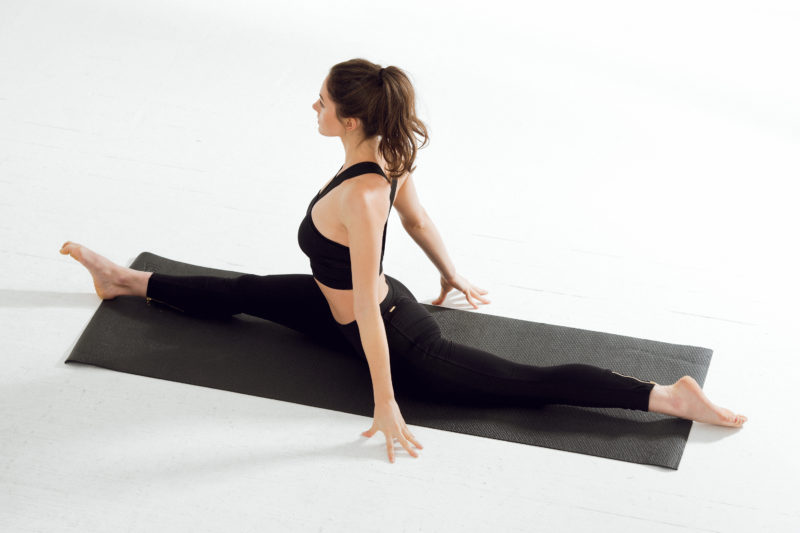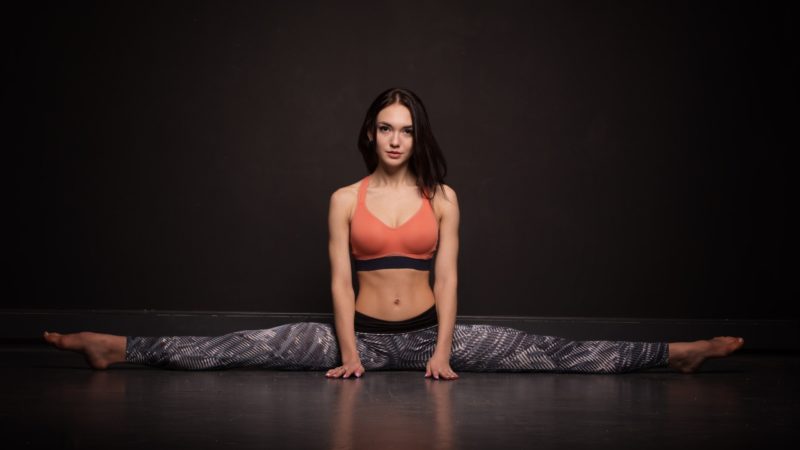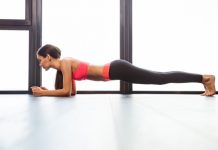To sit on the twine is not so difficult as it is customary to think. But not many people know that such flexibility will not only help to impress others, but will also have a positive impact on the health of a young gymnast. Twine exercises can be performed at home without special equipment. The effect of classes will not be long in coming and will be noticeable to everyone around.
Material Content:
Why sit on the twine
The ability to sit on a twine has many positive aspects. This is not only a beautiful acrobatic trick and an opportunity to surprise friends, but above all, it is a guarantee of a healthy future. Why is the ability to sit on the splits of an ordinary person, if he does not aspire to become a dancer or gymnast?
- Prevention and treatment of varicose veins. When performing stretching and the ability to sit on the twine, the vessels acquire elasticity, blood circulation is established, which favorably affects the condition of the veins on the legs.
- The increased elasticity of the ligaments and muscles that a person develops, learning to sit on the twine, will help to recover faster after any physical activities.
If the muscles stretch well, the likelihood of injury when falling falls several times.
- Increasing the flexibility of the joints of the pelvic zone, sacral region. Especially relevant for expectant mothers.
- A straight back and good posture are the first sign of an athletic person.In addition to acquiring a graceful gait, stretching exercises will relieve spinal pain and signs of scoliosis.
- Normalization of the intestines.
- Prevention of diseases of the genitourinary system.
- Willpower training. Here, as in any sport, to achieve a result you need to be patient and persistently go to your goal. Having achieved the result, the novice athlete will find inspiration and strength to overcome difficulties in any area of life.
- Self confidence. Twine stretching exercises will help to make legs slimmer, get rid of cellulite, tighten gluteal muscles and hips.
A good stretch is exclusively beneficial to those who exercise regularly. You can achieve improved health and visible results in just 30 minutes a day. For a faster result, it is recommended to practice in the morning and evening.
Varieties of twine
Speaking of twine, many have in mind its longitudinal appearance. But he has several varieties. To begin with, the twine can be divided into horizontal (sitting) and vertical (standing on one leg).
By the type of twine it happens:
- longitudinal - one leg is located in front of you, the other is behind;
- transverse - legs divorced to the right and left, form a straight line;
- suspended - the feet rest on supports (chairs), and the hips sag down, performed longitudinally and transversely;
- twine on the hands - is divided into two types, depending on the direction of the legs.
The vertical view of the twine can also be divided into longitudinal and transverse. It depends on whether to extend the leg lifted upward forward or sideways.
Rules for beginners
In order for the training process to have a positive effect on the body, and the athlete to enjoy the process, it is worth adhering to some rules:
- Do not rush. If you fail to develop flexibility in a couple of weeks, you should not give up and despair. The older the person, the more time he needs to develop muscle elasticity.
- Warm up, warm up. Muscles stretch well when the room temperature and body temperature are high enough.Before starting classes, you can take a hot shower, put on a warmer tracksuit, leggings on your feet and do a warm-up.
- You can start training with 10 - 15 minutes of basic exercises twice a day.
- Perform the exercises slowly, until you feel a slight pulling pain. At the time of the onset of pain, you should try to relax the muscles, in order to reduce pain, perform calm breaths and exhalations.
- Choose the most comfortable clothes.
- Keep your back straight during exercise. If you feel pain in the spine, change position, as this may indicate incorrect exercise.
- Both static twine exercises and dynamic ones should be performed.
Following these simple rules will help to avoid injuries and achieve the fastest result.
The most effective stretching exercises
According to studies, a person’s muscles in a month can stretch 3-4 cm without harm to health. Therefore, it makes no sense to set yourself the task of sitting on the splits in a few days if there is 10 or 20 cm left between the floor and the pelvis. A set of exercises for beginners will help you realize your dream without injuries. The time of its implementation depends on the initial preparation of the person.
For transverse twine
To sit on the transverse twine is more difficult than on the longitudinal.
To achieve the result, perform the following exercises:
- Put your legs wide so that your feet look in different directions. Then sit down, lowering the pelvis on the exhale, lingering in this pose with a straight back. After some time, rest your elbows near the knees on the inside of the hips, pull the body forward down and try to sit even deeper. It is allowed to carry out spring movement.
- Raise and take aside one knee, straighten the leg and raise the foot to the maximum height. Repeat 5 to 10 times on each leg.
- The legs are slightly wider than the shoulders; perform exhalation bends in turn to both legs. Then, lean forward as much as possible, trying to touch the floor with your hands, you can grab the calf muscles.
- Side lunges.
- Sitting on your heels, spread your hips to the sides, trying to touch the buttocks of the floor. If it does not work out, you can put a rolled towel or roller. Sitting buttocks on the floor, rotate the body on the exhale in both directions in turn, the spine reaches up.
- Standing on one knee, take the second straight leg to the side. On exhalation, both legs should separate. Reliance on the hands. The bent leg should remain bent. Perform on both legs alternately.
- "Butterfly". In a sitting position, connect the feet and pull them to the hips. Gradually lower your knees to the floor, your hands can hold your feet together or rest a little on your knees so that they fall down.
- In a sitting position, spread legs to the sides to the maximum distance. Lean forward, with your palms up, pull the tailbone back, and the crown forward. If possible, you can lean on your forearms. From the same position, stretch to each leg, trying to grab the foot with your hands. Keep your back straight.
- In the supine position, put the legs bent at the knees on the floor. Straighten one and lift up. To spread legs in different directions, holding a straight leg with a hand so that her toe is at ear level.
- From a lying position, raise your legs up and spread them apart. Hands can help a little while holding your knees extended. Socks of the feet are aimed at themselves. You can perform this exercise by pressing your pelvis against the wall.
This set of exercises is recommended to be performed daily.
For longitudinal
The following complex is an exercise for longitudinal twine:
- Lunges forward with arms raised. Pull the body up, and direct the pelvis down, until tension occurs in the muscles.
- In the lunge, lean on the elbows of both hands. Arms should be placed on one side of the bent leg.
- In the lunge, lower the knee of the straight back leg. Perform small springing movements, trying to stretch the muscles more. Hands can lean on the floor or rest against them in the gluteal muscles.
- From the same position on the exhale, straighten the legs, the tailbone up. Put your hands on the floor near the front leg, pull your forehead towards the calf.
- Stand on one knee with one foot, stretch the other forward, leaning on the heel, and point the sock towards you. Make a slope down. Hands can be extended forward or bent at the elbows and lean on them. To enhance the effect of stretching, you can put a foot on a chair bent at the knee.
- From the pose of the “dove”, when sitting on the floor one leg bends under itself so that the heel is under the opposite pelvic bone. The other leg is stretched straight back. Slowly move the shin of the bent leg forward, while the tailbone and pelvis are lowered. To complicate, take the back leg with the same hand by the foot or lower leg and pull it to the gluteus maximus. Then change hands, lean forward, put your forehead on your hand.
- In a supine position, straighten one leg, grab the foot with your hand and pull it towards you.
- In the “dog face down” pose, lower the head so that the shoulders are at the level of the ears, in turn put one foot on the toe. At the same time, try not to tear off the heel of the other leg from the floor.
- From the pose of the “dog head down”, lift the legs in turn back and up, thigh pointing inward.
- In a standing position, bend one leg, lifting the foot to the buttock. Holding the leg with your hand, raise it up to the highest possible height.
By performing the above most effective stretching exercises, you can develop the muscles of both legs.
What you should not do
Excessive rush, training with severe pain can lead to serious injuries. Therefore, if sharp pain is felt during the training, it is necessary to stop performing the exercise, take a comfortable position and see a doctor.
You should not hold your breath at the time of exercise, this can lead to excessive muscle tension. Calm breathing and pleasant music will help to relax.
You cannot ask for help from other people. Only a qualified trainer will be able to correctly help you complete the exercise without harming it. You can sit on the twine without assistance.
Contraindications of this type of exercise
Despite the undoubted benefit of stretching exercises, this type of exercise has its contraindications.
Caution should be taken if there are the following ailments:
- the presence of intervertebral hernia;
- diseases of the knees and joints;
- hypertension (high blood pressure)
- injuries and inflammatory processes in the knees, groin tendons, hip area.
Caution should be exercised when performing stretch marks during exacerbation of certain gynecological diseases, in the presence of a genitourinary infection.
Tips gymnasts and ballerinas
All famous gymnasts and ballerinas know how to sit on the twine, but it was not given to them immediately. They have come a long way to gain flexibility and develop talent.
Beginners should follow the advice of professionals:
- To get the result, you need to learn how to maximize muscle relaxation during stretch marks. So the result will come faster, the likelihood of injury will be reduced.
- A large amount of water and a balanced diet will help increase muscle elasticity. A large amount of meat in the diet makes the muscles hard, difficult to stretch.
- In any position, it is important to monitor posture. Always keep your back straight, do not stoop, straighten your shoulders.
- Straighten your knees, otherwise you can damage the tendons.
- To distract from pain, monitor breathing. This will switch attention.
Fulfilling all the recommendations, adhering to the training regimen and necessarily performing warm-up, any person will be able to stretch his muscles enough to sit on the twine.


















